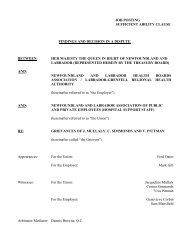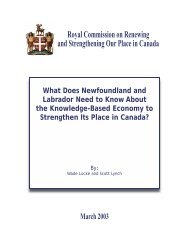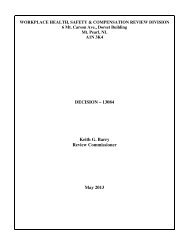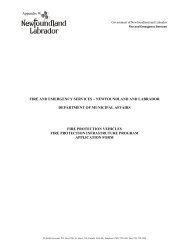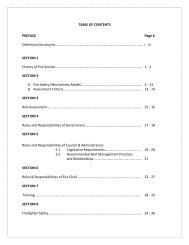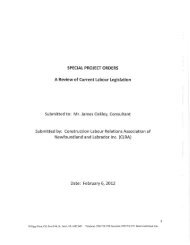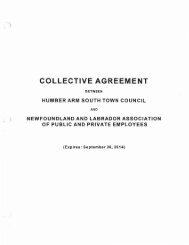Energy Plan - Government of Newfoundland and Labrador
Energy Plan - Government of Newfoundland and Labrador
Energy Plan - Government of Newfoundland and Labrador
Create successful ePaper yourself
Turn your PDF publications into a flip-book with our unique Google optimized e-Paper software.
POLICY<br />
ACTIONS<br />
Holyrood<br />
The <strong>Government</strong> <strong>of</strong> <strong>Newfoundl<strong>and</strong></strong><br />
<strong>and</strong> <strong>Labrador</strong> will address environmental<br />
concerns related to Holyrood by either:<br />
A. Replacing Holyrood<br />
generation with electricity<br />
from the Lower Churchill<br />
through a transmission link<br />
to the Isl<strong>and</strong>; or<br />
B. Installing scrubbers <strong>and</strong><br />
precipitators, <strong>and</strong> maximize<br />
the use <strong>of</strong> wind, small<br />
hydro <strong>and</strong> energy efficiency<br />
programs, to reduce reliance<br />
on Holyrood.<br />
One <strong>of</strong> the goals <strong>of</strong> this <strong>Energy</strong> <strong>Plan</strong> is to maximize the value from resource<br />
developments, including the benefits from wind generation. To maximize these<br />
benefits, the Provincial <strong>Government</strong> believes the <strong>Energy</strong> Corporation should<br />
control the development <strong>of</strong> all wind projects <strong>and</strong> determine when to develop<br />
alone or with private sector partners. We will enable this by adopting a policy<br />
that no new leases for wind development on crown l<strong>and</strong> will be issued except<br />
to the <strong>Energy</strong> Corporation or another company acting in partnership with the<br />
<strong>Energy</strong> Corporation.<br />
The wind industry can also be a major employer in the province if we capitalize<br />
on the significant manufacturing <strong>and</strong> fabrication opportunities associated with<br />
large-scale wind projects. We can utilize the skills <strong>and</strong> infrastructure we have<br />
developed in our manufacturing <strong>and</strong> fabrication sector to exp<strong>and</strong> into activity<br />
related to the wind power industry.<br />
Holyrood<br />
In an average year, the Holyrood Thermal Generating Station (Holyrood) provides<br />
about one-quarter <strong>of</strong> the electric power capacity on the isl<strong>and</strong> <strong>of</strong> <strong>Newfoundl<strong>and</strong></strong>.<br />
It burns heavy fuel oil, also referred to as Number 6 fuel oil or Bunker-C <strong>and</strong>,<br />
on average, emits 1.3 million tonnes <strong>of</strong> GHGs <strong>and</strong> significant amounts <strong>of</strong> other<br />
pollutants. However, this facility is essential to the Isl<strong>and</strong> system. As the only<br />
major generating facility on the Avalon Peninsula, it provides generating capacity<br />
to meet peak winter dem<strong>and</strong> <strong>and</strong> voltage support within the largest load centre.<br />
During dry periods, when less water is available for hydro generation, Holyrood<br />
use increases significantly.<br />
Holyrood presents the biggest challenges for the Isl<strong>and</strong> system in the nearterm.<br />
The cost <strong>of</strong> operating Holyrood has increased along with world oil prices,<br />
resulting in a large portion <strong>of</strong> the rate increases for Isl<strong>and</strong> customers in recent<br />
years. Because it produces significant amounts <strong>of</strong> polluting emissions <strong>and</strong><br />
GHGs, it also creates a negative impact on the environment. In a preliminary<br />
effort to address this issue, the province, through NLH, has assessed several<br />
options, leading to the decision by the Provincial <strong>Government</strong> to m<strong>and</strong>ate the<br />
use <strong>of</strong> lower-sulphur fuel at Holyrood in the short-term. This action is expected<br />
to reduce sulphur dioxide (SO 2<br />
) by 50 per cent <strong>and</strong> particulate emissions by<br />
40 per cent. In addition, NLH’s recent awards for 51MW <strong>of</strong> wind generation<br />
will reduce the requirement for thermal generation <strong>and</strong> related emissions by<br />
approximately 15 per cent. Our renewed efforts to improve energy efficiency<br />
will also lower the emissions from Holyrood. Depending on the outcome <strong>of</strong> an<br />
assessment <strong>of</strong> emissions from burning lower-sulphur fuel, the maximum sulphur<br />
content <strong>of</strong> the fuel may be lowered further in the future, though this measure<br />
will result in an increase in fuel costs.<br />
38<br />
In the long-term, the current level <strong>of</strong> emissions from the Holyrood facility is<br />
unacceptable. The Provincial <strong>Government</strong>, through NLH, has investigated the<br />
long-term options to address Holyrood emissions <strong>and</strong> decided to replace Holyrood<br />
generation with electricity from the Lower Churchill through a transmission link<br />
to the Isl<strong>and</strong>. This replacement provides an excellent opportunity to partner<br />
with the Federal <strong>Government</strong> to reduce GHG emissions.



